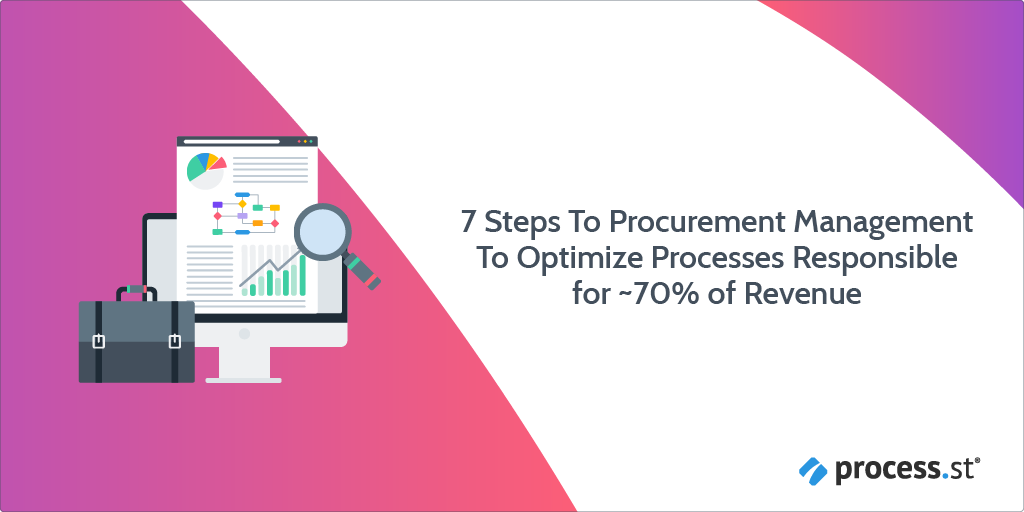
Procurement management directly impacts an organization’s bottom-line and can be responsible for 70% of revenue. With this in mind, it’s important to get procurement right.
The world of procurement has undergone tremendous changes in the past couple of years. Changes of particular importance when thinking about procurement management include:
- Digital transformation: With 85% of organizations believing that this digital transformation will change the way they deliver services over the next 3-5 years.
- Thinking about suppliers beyond price: With a greater focus on supplier synergies. The importance of supplier visibility regarding the procurement steps is realized.
- Moving to effective change management: Organizations focus on a smooth change management plan, with procurement leaders agreeing change management is the biggest roadblock to achieving procurement goals.
- Risk management and preparing the unexpected: With transparent procurement systems reducing risk exposure. Only 65% of procurement leaders have little or no visibility in their supply chain.
With this in mind, in this Process Street article, we explain how you can create a procurement management solution that leverages a digital transformation (using Process Street as your procurement management software), thinks about suppliers beyond price, and incorporates effective risk and change management.
Click on the relevant subheader below to jump to your section of choice. Alternatively, scroll down to read all we have to say on procurement management.
- What is procurement? A re-cap of the basics
- Examples of procurement gone wrong
- What is procurement management (+ benefits)
- Procurement management best practice
- Procurement management plan in 7 steps
What is procurement? A re-cap of the basics
Procurement is the action of obtaining something. We’re talking about making physical transactions to purchase deals of goods and services. But procurement does not solely focus on the transaction; it’s the thinking behind the action as a process.
As you probably know, we have 2 top articles on procurement – ⬇ given below ⬇. These articles focus on procurement and the processes involved. Today, we’ll be taking a look at procurement management specifically, but before doing, let’s re-cap the basics.
- How to Implement a Powerful Procurement Process Like a Pro (Free Templates!)
- Digital Procurement: How to Cut Costs Without Losing Profitability
Why you need to get procurement right
Procurement is about managing supplier relationships to avoid expensive mishaps. The top 78% of procurement leaders are focussed on cost reduction, and look to optimize procurement processes to achieve this aim.
Procurement directly impacts a company’s profit, and can often be responsible for up to 70% of an organization’s revenue.
I guess the next question is, how do you get procurement right?
For that, you need two things:
- An optimized procurement process.
- Optimal procurement management.
The latter is the prime focus of this article. I’ll briefly touch on the procurement process but leave the details to the top resources presented above.
The procurement process
“My whole job is to help people throughout their procurement process. So we would just get the process built.” – John Cunnigham, Business Process Advisor at Process Street
A procurement process is all the steps and tasks needed to complete procurement successfully. Without a standard process for procurement, you and your team will continually go about procurement poorly which could increase organizational expense.
To help you get your procurement process right, we at Process Street have taken the best procurement practices and transcribed these into a documented checklist process.
Although a company’s procurement process will be influenced by factors like the company’s size, industry, available human resources, and organizational structure, this Process Street checklist will give you the structural foundation you need. It will explain, step-by-step, how to identify the true needs of your organization, find the perfect supplier to fulfill those needs, and negotiate favorable contract terms and pricing.
“…every single time we go through the procurement process, we’ll run this Checklist. So that way that the same steps are followed every single time.” – Cynthia Stirling, N5Now
Create your free Process Street account to get started!
Click here to access our Procurement Process Checklist Template!
Key checklist features include:
- Approvals ✅: Allowing you to give the go-ahead or rejection on important items, such as purchase requests and contract proposals.
- Conditional Logic : To create a dynamic system that caters to your needs. In this case, you can detail issues with the procurement order.
- Task permissions : These help you hide specific tasks in the procurement process from view for different users, making your checklists more private.
- Embed Widget : This allows you to view and interact with other apps without leaving your documented process in Process Street. In this case, you can send an invoice to accounts from the procurement checklist.
What is procurement management (+ benefits)
Procurement management is about acquiring quality goods and services from preferred vendors within a stipulated budget, on or before a deadline. It details how the procurement process will be managed.
A procurement management plan will include the following information:
- The types of contracts you plan to use and any metrics that will be used to measure the contractor’s performance.
- The planned delivery dates for the work or products you’re contracting.
- The company’s standard documents you will use.
- The number of vendors or contractors involved and how they will be managed.
- How purchasing may impact the constraints and assumptions made during procurement.
- The coordination of purchasing lead times with the development of the project schedule.
- The identification of prequalified sellers (if known).
Handling the organization’s procurement is one thing; effectively managing it is another. Good procurement management has the power to save money and time while increasing organizational compliance.
Procurement management controls costs, compliance, and improves supplier management
An effective procurement management system will deliver the following benefits, as given by Oracle:
- Increases spending influence
Procurement solutions enforce compliance purchasing by making it easy for employees to find what they need and direct approved purchases from authorized suppliers. - Improves efficiency and automates sourcing and purchasing processes
Cumbersome procurement processes limit value-delivery to an organization. Procurement management solutions standardize, streamline, and automate traditionally manual processes. This frees up resources and time for other strategic business processes. - Improves supplier management
Qualifying and assessing a potential supplier’s capabilities, viability, and compliance with the company’s code of conduct is essential. Alerts prompt procurement professionals when a supplier’s qualifications are expiring. Also, procurement keeps on top of information that might affect supplier qualifications, capabilities, and changes to their risk profile. - Standardizes the contract lifecycle
Contract reviewers can identify deviations from the standard language and identify risks, make changes as required, and gain approval before finalization. Alerts notify users of expiring contracts to ensure timely renewals and to minimize delays.
Examples of procurement gone wrong
To truly emphasize the importance of procurement management, we’ll take a look at what happens when poor management processes are in place.
Disappearing inventory at Asos

Towards the end of July 2019, as peak season was coming into full view, the e-commerce-driven fashion brand, Asos, told investors about a costly warehouse technology failure.
The high trend-driven brand was tracking stock inventory using a stock-keeping unit (SKU), which is a scannable bar code printed on the clothing item labels. This allowed vendors to automatically track inventory movement. The organization was adding 5,000 SKUs per week – which gives you a sense of the inventory scale we’re dealing with.
Asos relied on an automated system to manage its inventory levels. However, the breakdown of this system led to a major procurement failure. That is, the automated system was sending inventory out to complete orders, but not taking new orders in for weeks – e.g. new items, replenishment, and customer returns.
This procurement error restricted stock availability for customer margins across Germany, France, and the U.S, with a 68% drop in profits year-over-year for the 2019 fiscal year.
For a procurement blunder to rise to such a level that the media gets hold of it, then we know the situation is bad. It took months for Asos to identify and address the $30 million procurement problem.
A laboratory lapse in procurement, involving 500 test tubes

If you’ve read any of my previous articles, you’ll be aware that before Process Street, I worked at an environmental testing laboratory. During my time at this laboratory, the importance of procurement management truly hit home.
In my first month, I was charged with ordering test tube containers from our contractor, for delivery to a client. However, instead of ordering 50 tubes, I accidentally put an inventory order in for 500…
You can imagine the horror felt by the client when a truck of 500 test tubes arrived at their door-step.
I hang my head in shame.
Of course, the fault rested on my shoulders. However, having a stricter approval process for procurement requests would help catch and reduce human error from the process.
Procurement management best practices
The procurement management practices below are prescribed as correct and the most effective procedures, to reduce inefficiencies and prevent damaging vendor relations.
1. Prioritize transparency
Prioritize transparency by processing purchases, invoices, and vendor monitoring using a single platform. This ensures open communication and accountability during each stage of procurement, for both the buyer and the seller.
By keeping information on a single system, your procurement team can get the data analytics they need to take advantage of discounts, avoid late or double payments, and keep vendors happy.
The best way you can optimize transparency is by documenting your procurement processes. Whether that’s vendor management procedures, managing accounts payable, or completing a purchase order workflow – document it.
You can document any business process using Process Street, as you saw in our Procurement Process Checklist Template given above. For more information on how to create and edit templates in Process Street, watch the below video:
You can create your free Process Street account here to get started.
2. Optimize your inventory
Managing stock and intake, while maintaining bottom lines can be a daunting challenge. Keeping inventory at an optimal level requires careful planning of purchase quantities to minimize waste while delivering on customer expectations. Your inventory needs to rotate smoothly and regularly to lower your overall risk and unnecessary expenses. Make sure your procurement management plan optimizes your inventory.
3. Engage suppliers
Building a solid relationship with your suppliers is vital for your organization’s success. Essential product delivery and routine maintenance are key components for any smooth-running business strategy.
Ensuring your vendors deliver reliable, high-quality goods and services on time (and at the best rate) requires strategic relationships with your suppliers.
For this, you need to have better insight into your suppliers, meaning you can track performance and evaluate these relationships. With more data on vendor’s performance, you can engage them in a meaningful way that will ensure your business needs are being met.
4. Automate procurement
Efficient procurement processes will save your business both time and money, with inefficient procurement costing businesses $1.5 billion annually.
Automation minimizes repetitive operational processes, giving procurement teams more time to contribute to other important tasks. For instance, with automation, the human component of data entry and costly errors can be avoided.
To find out how you can automate your procurement processes using Process Street, read:
- The Ultimate Guide to Business Process Automation
- 50 Ways To Save Time & Money with Workflow Automation
- What is Form Automation Software? How to Pick the Best Form Software
- Ultimate Guide to Small Business Automation with Zapier
5. Integrate procurement processes
Having disparate procurement systems will slow work down by creating barriers and system gaps between one procurement process and another. Think about it, processes such as budget requests, quality checks, and dispatch authorization demand some manual action. If these processes are not integrated, then the procurement system will operate haphazardly, and act as a stop-start process labored with bottlenecks.
Integrating various procurement processes ensures a smooth, streamlined system from start to finish via bridging gaps between one procurement process and another.
6. Minimize risk
You need to consider the risks involved in every business decision and have appropriate risk management processes in place accordingly. Legislation around compliance, bribery, traceability, health and safety, green issues, and social responsibility are all factors that impact procurement decisions to be made.
Procurement teams have to equip themselves with knowledge of all these elements and manage them to reduce business risk.
Procurement management plan in 7 steps

To effectively manage a company’s procurement needs, it’s important to have a thorough procurement management plan based on solid information.
Procurement management follows a logical order:
- You plan what you need to contract.
- You plan how you’ll do it.
- You’ll send out your contract requirements to vendors.
- Vendors will bid for a chance to work with you.
- You’ll continuously monitor work done, close out the contract, and complete all associated paperwork.
To help you formulate an effective procurement management plan, we’ve split the management procedure down into 6 steps, as follows.
Step #1: Define roles and responsibilities
Everyone involved in the procurement process needs to understand the responsibilities and scope of their work. Boundaries between responsibilities also need to be set.
Important roles defined in the procurement management plan include project managers, corporate executives, and contract managers.
You can use Process Street’s Role Assignments features to assign tasks to given team members for your procurement processes.
Step #2: Create a schedule
A procurement management plan should contain scheduling details to make sure that the procurement processes are completed within the expected timeline.
Break down procurement projects into constituent tasks – something you’ll do when documenting your processes in Process Street. Give start and estimated end dates to the given tasks.
Step #3: Identify and mitigate risks
Risks are inherent in every part of project management, and procurement management is no exception. A procurement management plan helps figure out what those risks might be and lists them out.
Once an insightful list of risks is collected, use your procurement plan to help mitigate them. Assign team members to distribute ownership of given risk types.
Step #4: Determine costs
Cost determination is a crucial step in creating a procurement management plan as it directly affects the budget. These steps involve issuing a request for a proposal that asks vendors to offer bids for their products or services.
The request for a proposal generally involves critical schedule dates and provides details on the vendor’s work arrangement, and previous experience.
During this step, you should also conduct a make-or-buy analysis, to figure out whether or not you should be contracting the work or doing it yourself. Think about…
- What’s the cost to build it as opposed to buying it?
- How will this decision affect the scope of your project/service/product?
- How will it affect the project/service/product schedule?
- Do you have time to do the work and still meet your commitments?
- As you plan out what you will and won’t contract, you need to think through your reasoning carefully.
You may need to rent, buy, or lease machinery/equipment to meet your procurement needs if you decide to not buy-in. You’ll therefore need to examine leasing-versus-buying costs to determine the best way to move forward.
Step #5: Establish decision criteria and approval workflow
This section of the procurement management plan outlines the approval workflow for different contracts. It specifies the elements required before the final approval – e.g. cost analysis.
This stage of procurement management is made easy using Process Street’s Approvals feature. With this feature, vendor contracts are reviewed and approved from a single checklist platform.
“[documenting procurement processes]…in the system, everything’s in one place” – Steve Rye, AstraZeneca Product Owner
There are two different contract types to consider during this step in procurement management, as shall be discussed after this section, keep reading.
Step #6: Establish vendor management
This step specifies strategies and protocols used for vendor management. This way, businesses ensure vendors provide acceptable goods and services within the expected timeline. Moreover, this step may also detail processes for invoice processing, status reporting, and timesheet approval.
Vendors and suppliers usually require payments during the life of the contract, as opposed to at the end of a contract. Scheduled payments are needed as part of the contract, and are usually made based on progress. These are called progress payments.
With progress payments, there’s a defined amount of work to be accomplished in a given time frame, and a quality standard is set for the work to achieve before the contractor is paid.
Vendor management also defines the scope of work to be completed by the vendor.
Often, events will occur that’ll demand changes in the contractor’s scope of work. In these instances, you’ll need a method of managing these changes, which should be detailed in the contract.
That is, for effective procurement management, you’ll need to:
- Capture the changes early.
- Document what changed.
- Document how the change impacted the contract.
- Develop the change order.
Conflict among team members may arise when changes are not documented or when the team cannot agree on the change. This is why you need an effective change management plan. Find out how you can develop such as plan by reading:
- 8 Critical Change Management Models to Evolve and Survive
- How to Apply 7 Change Management Principles to Your Remote Workforce
- How to Make a Change Management Strategy (and Defuse the Growth Time Bomb)
Step #7: Review and approval processes
After the decision has been made to purchase goods or outsource services, the final procurement plan needs to be sent for review and approval. This procurement plan should include the following:
- A thorough detail of the relationships and contract approaches for each type of purchased goods or outsourced services.
- Prepared requests for quotes (RFQs), requests for proposals (RFPs), and mapped partnership opportunities.
- A thorough evaluation of RFQs, RFPs, and partnerships.
- Documented awarded and signed contracts, securely stored.
- Mapped quality and timely performance.
- Managed contract changes.
- Documented and securely stored closed contracts.
Contract types

You must know about the major types of contracts available, for you to choose one that creates a fair and workable deal.
The two main contracts to consider are:
- Fixed-price contracts
- Cost-reimbursable contracts
Let’s take a look at these contract types in more detail.
Fixed-price contracts
A fixed-price contract is a legal agreement between an organization and an entity to provide goods or services at an agreed-on price.
For these contracts, the quality of goods and services are given, including the timing needed to support the project, and the price for delivering goods or services.
Fixed-price contracts work best when the work scope is clear and not likely to change – the responsibility for managing the work to meet the organization’s needs is focused on the contractor.
To make sure the contractor meets the project needs, the project team tracks quality and schedules progress.
Fixed-price contracts are vulnerable to circumstance changes that could bump up the price. For instance, say you have a project to be completed on a given time-scale, yet delays meant the vendor contract length had to be extended. The price for such contract changes is usually high.
To offset this risk, sometimes the change price is included in the original contract. However, this will incur higher total project costs than other vendor contract forms, as the risk costs are transferred to the contractor. The contractor will add a contingency to the contract to cover their additional risk.
Cost-reimbursable contracts
In a cost-reimbursable contract, the organization agrees to pay the contractor the cost of performing the service or providing the goods. These contract types are also known as cost-plus contracts.
These contract types are most used when the scope of work or the costs for performing the work are known. If there are changes to the costs associated with the given project, then the contractor is reimbursed for these costs. This type of contract reduces the risk of cost fluctuations for the contractor.
It must be noted that each step in procurement management can take either hours or sometimes weeks of work to complete. Time is an important determinant when deciding vendor contract types. Sometimes it may take you too long to deliver the needed output without vendor help, meaning extra expenses for new contracts are necessary.
Use Process Street to embrace the significant changes in procurement management
Using Process Street for procurement management allows you to leverage changes in procurement, and capture optimal vendor opportunities.
Process Street provides a digital procurement solution, one that also allows you to manage change and risk – two important procurement influences.
Also, the transparency given by documenting procurement processes means you can think about suppliers beyond price, and develop positive supplier synergies.
With this in mind, what are you waiting for?
Create your free Process Street account and get started today!
How do you manage procurement in your organization? What successes and challenges have you faced? We’d love to hear from you in the comments below!







Jane Courtnell
Hi there, I am a Junior Content Writer at Process Street. I graduated in Biology, specializing in Environmental Science at Imperial College London. During my degree, I developed an enthusiasm for writing to communicate environmental issues. I continued my studies at Imperial College's Business School, and with this, my writing progressed looking at sustainability in a business sense. When I am not writing I enjoy being in the mountains, running and rock climbing. Follow me at @JaneCourtnell.